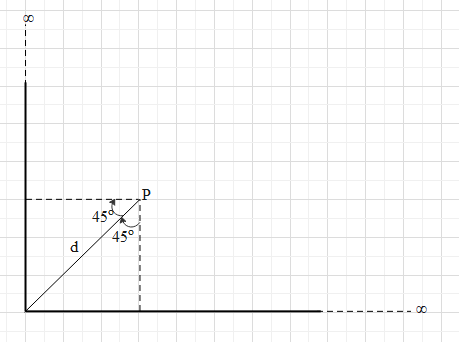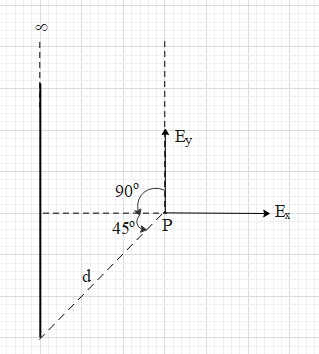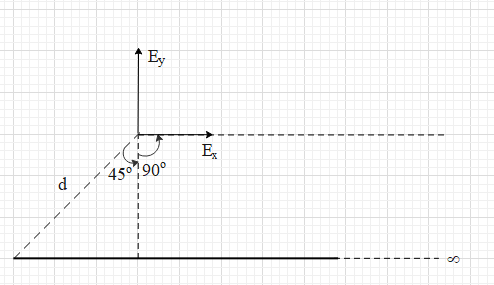
Two infinitely long uniformly charged rods are joined as shown in the figure. The linear charge density on the rod is $\lambda =\dfrac{Q}{L}$, Q is the total charge on each rod and L is the length of each rod. Find the electric field in vector form at point P due to the two rods.


Answer
573.3k+ views
Hint: Understand how uniformly charged rod of some length produces an electric field at point P that is at a perpendicular distance d from the rod. Apply this formula for both the given rods and calculate the net electric field at point P.
Formula used:
${{E}_{x}}=\dfrac{\lambda }{4\pi {{\varepsilon }_{0}}d}\left( \sin {{\theta }_{1}}+\sin {{\theta }_{2}} \right)$
${{E}_{y}}=\dfrac{\lambda }{4\pi {{\varepsilon }_{0}}d}\left( \cos {{\theta }_{1}}-\cos {{\theta }_{2}} \right)$
Complete step by step answer:
Let them understand the electric field due to a charged finite rod.
Suppose a uniformly charged rod of linear charge density $\lambda $ is placed vertically as shown. Then the electric field at a point P that is at a perpendicular distance d from the rod is given as:
${{E}_{x}}=\dfrac{\lambda }{4\pi {{\varepsilon }_{0}}d}\left( \sin {{\theta }_{1}}+\sin {{\theta }_{2}} \right)$
And
${{E}_{y}}=\dfrac{\lambda }{4\pi {{\varepsilon }_{0}}d}\left( \cos {{\theta }_{1}}-\cos {{\theta }_{2}} \right)$

Here, ${{E}_{x}}$ is the horizontal component of the electric field and ${{E}_{y}}$ is the vertical component of the electric field.
${{\theta }_{1}}$ and ${{\theta }_{2}}$ are the angles as shown in the figure.
Therefore, in vector form the electric field will be $E=\dfrac{\lambda }{4\pi {{\varepsilon }_{0}}d}\left( \sin {{\theta }_{1}}+\sin {{\theta }_{2}} \right)\widehat{i}+\dfrac{\lambda }{4\pi {{\varepsilon }_{0}}d}\left( \cos {{\theta }_{1}}-\cos {{\theta }_{2}} \right)\widehat{j}$
Let us now find the net electric field to the two rods as per arrangements shown in the figure of the question.
Let us find the electric field (${{E}_{1}}$) due to the vertical rod. For this rod, the perpendicular distance of the point P is $d\cos 45=\dfrac{d}{\sqrt{2}}$.

Since the rod is going up till infinity, ${{\theta }_{1}}\approx {{90}^{\circ }}$.
From the figure, ${{\theta }_{2}}={{45}^{\circ }}$.
Therefore,
$\Rightarrow {{E}_{1}}=\dfrac{\lambda }{4\pi {{\varepsilon }_{0}}\dfrac{d}{\sqrt{2}}}\left( \sin 90+\sin 45 \right)\widehat{i}+\dfrac{\lambda }{4\pi {{\varepsilon }_{0}}\dfrac{d}{\sqrt{2}}}\left( \cos 90-\cos 45 \right)\widehat{j}$
$\Rightarrow {{E}_{1}}=\dfrac{\sqrt{2}\lambda }{4\pi {{\varepsilon }_{0}}d}\left( 1+\dfrac{1}{\sqrt{2}} \right)\widehat{i}+\dfrac{\sqrt{2}\lambda }{4\pi {{\varepsilon }_{0}}d}\left( 0-\dfrac{1}{\sqrt{2}} \right)\widehat{j}$
$\Rightarrow {{E}_{1}}=\dfrac{\left( \sqrt{2}+1 \right)\lambda }{4\pi {{\varepsilon }_{0}}d}\widehat{i}-\dfrac{\lambda }{4\pi {{\varepsilon }_{0}}d}\widehat{j}$
Let us find the electric field (${{E}_{2}}$) due to the horizontal rod.

Here, the perpendicular distance is $d\cos 45=\dfrac{d}{\sqrt{2}}$.
${{\theta }_{1}}\approx {{90}^{\circ }}$ and ${{\theta }_{2}}={{45}^{\circ }}$.
However, in this case the horizontal component will be ${{E}_{x}}=\dfrac{\lambda }{4\pi {{\varepsilon }_{0}}d}\left( \cos {{\theta }_{1}}-\cos {{\theta }_{2}} \right)$.
The vertical component will be ${{E}_{y}}=\dfrac{\lambda }{4\pi {{\varepsilon }_{0}}d}\left( \sin {{\theta }_{1}}+\sin {{\theta }_{2}} \right)$.
Since the data is same, we get that
${{E}_{2}}=\dfrac{-\lambda }{4\pi {{\varepsilon }_{0}}d}\widehat{i}+\dfrac{\left( \sqrt{2}+1 \right)\lambda }{4\pi {{\varepsilon }_{0}}d}\widehat{j}$
The net electric field at point P is $\overrightarrow{E}=\overrightarrow{{{E}_{1}}}+\overrightarrow{{{E}_{1}}}$.
$\Rightarrow \overrightarrow{E}=\dfrac{\left( \sqrt{2}+1 \right)\lambda }{4\pi {{\varepsilon }_{0}}d}\widehat{i}-\dfrac{\lambda }{4\pi {{\varepsilon }_{0}}d}\widehat{j}+\dfrac{-\lambda }{4\pi {{\varepsilon }_{0}}d}\widehat{i}+\dfrac{\left( \sqrt{2}+1 \right)\lambda }{4\pi {{\varepsilon }_{0}}d}\widehat{j}$
$\Rightarrow \overrightarrow{E}=\dfrac{\sqrt{2}\lambda }{4\pi {{\varepsilon }_{0}}d}\widehat{i}+\dfrac{\sqrt{2}\lambda }{4\pi {{\varepsilon }_{0}}d}\widehat{j}$
$\Rightarrow \overrightarrow{E}=\dfrac{\sqrt{2}\lambda }{4\pi {{\varepsilon }_{0}}d}\left( \widehat{i}+\widehat{j} \right)$
It is given that $\lambda =\dfrac{Q}{L}$.
$\Rightarrow \overrightarrow{E}=\dfrac{\sqrt{2}Q}{4\pi {{\varepsilon }_{0}}dL}\left( \widehat{i}+\widehat{j} \right)$
The above expression is the net electric field in vertical form at point P.
Note:
Note that the formula for the horizontal and vertical components of the electric due to a vertical rod is applicable only for a vertical rod. When the rod rotates by 90 degrees, the formula will change.
Formula used:
${{E}_{x}}=\dfrac{\lambda }{4\pi {{\varepsilon }_{0}}d}\left( \sin {{\theta }_{1}}+\sin {{\theta }_{2}} \right)$
${{E}_{y}}=\dfrac{\lambda }{4\pi {{\varepsilon }_{0}}d}\left( \cos {{\theta }_{1}}-\cos {{\theta }_{2}} \right)$
Complete step by step answer:
Let them understand the electric field due to a charged finite rod.
Suppose a uniformly charged rod of linear charge density $\lambda $ is placed vertically as shown. Then the electric field at a point P that is at a perpendicular distance d from the rod is given as:
${{E}_{x}}=\dfrac{\lambda }{4\pi {{\varepsilon }_{0}}d}\left( \sin {{\theta }_{1}}+\sin {{\theta }_{2}} \right)$
And
${{E}_{y}}=\dfrac{\lambda }{4\pi {{\varepsilon }_{0}}d}\left( \cos {{\theta }_{1}}-\cos {{\theta }_{2}} \right)$

Here, ${{E}_{x}}$ is the horizontal component of the electric field and ${{E}_{y}}$ is the vertical component of the electric field.
${{\theta }_{1}}$ and ${{\theta }_{2}}$ are the angles as shown in the figure.
Therefore, in vector form the electric field will be $E=\dfrac{\lambda }{4\pi {{\varepsilon }_{0}}d}\left( \sin {{\theta }_{1}}+\sin {{\theta }_{2}} \right)\widehat{i}+\dfrac{\lambda }{4\pi {{\varepsilon }_{0}}d}\left( \cos {{\theta }_{1}}-\cos {{\theta }_{2}} \right)\widehat{j}$
Let us now find the net electric field to the two rods as per arrangements shown in the figure of the question.
Let us find the electric field (${{E}_{1}}$) due to the vertical rod. For this rod, the perpendicular distance of the point P is $d\cos 45=\dfrac{d}{\sqrt{2}}$.

Since the rod is going up till infinity, ${{\theta }_{1}}\approx {{90}^{\circ }}$.
From the figure, ${{\theta }_{2}}={{45}^{\circ }}$.
Therefore,
$\Rightarrow {{E}_{1}}=\dfrac{\lambda }{4\pi {{\varepsilon }_{0}}\dfrac{d}{\sqrt{2}}}\left( \sin 90+\sin 45 \right)\widehat{i}+\dfrac{\lambda }{4\pi {{\varepsilon }_{0}}\dfrac{d}{\sqrt{2}}}\left( \cos 90-\cos 45 \right)\widehat{j}$
$\Rightarrow {{E}_{1}}=\dfrac{\sqrt{2}\lambda }{4\pi {{\varepsilon }_{0}}d}\left( 1+\dfrac{1}{\sqrt{2}} \right)\widehat{i}+\dfrac{\sqrt{2}\lambda }{4\pi {{\varepsilon }_{0}}d}\left( 0-\dfrac{1}{\sqrt{2}} \right)\widehat{j}$
$\Rightarrow {{E}_{1}}=\dfrac{\left( \sqrt{2}+1 \right)\lambda }{4\pi {{\varepsilon }_{0}}d}\widehat{i}-\dfrac{\lambda }{4\pi {{\varepsilon }_{0}}d}\widehat{j}$
Let us find the electric field (${{E}_{2}}$) due to the horizontal rod.

Here, the perpendicular distance is $d\cos 45=\dfrac{d}{\sqrt{2}}$.
${{\theta }_{1}}\approx {{90}^{\circ }}$ and ${{\theta }_{2}}={{45}^{\circ }}$.
However, in this case the horizontal component will be ${{E}_{x}}=\dfrac{\lambda }{4\pi {{\varepsilon }_{0}}d}\left( \cos {{\theta }_{1}}-\cos {{\theta }_{2}} \right)$.
The vertical component will be ${{E}_{y}}=\dfrac{\lambda }{4\pi {{\varepsilon }_{0}}d}\left( \sin {{\theta }_{1}}+\sin {{\theta }_{2}} \right)$.
Since the data is same, we get that
${{E}_{2}}=\dfrac{-\lambda }{4\pi {{\varepsilon }_{0}}d}\widehat{i}+\dfrac{\left( \sqrt{2}+1 \right)\lambda }{4\pi {{\varepsilon }_{0}}d}\widehat{j}$
The net electric field at point P is $\overrightarrow{E}=\overrightarrow{{{E}_{1}}}+\overrightarrow{{{E}_{1}}}$.
$\Rightarrow \overrightarrow{E}=\dfrac{\left( \sqrt{2}+1 \right)\lambda }{4\pi {{\varepsilon }_{0}}d}\widehat{i}-\dfrac{\lambda }{4\pi {{\varepsilon }_{0}}d}\widehat{j}+\dfrac{-\lambda }{4\pi {{\varepsilon }_{0}}d}\widehat{i}+\dfrac{\left( \sqrt{2}+1 \right)\lambda }{4\pi {{\varepsilon }_{0}}d}\widehat{j}$
$\Rightarrow \overrightarrow{E}=\dfrac{\sqrt{2}\lambda }{4\pi {{\varepsilon }_{0}}d}\widehat{i}+\dfrac{\sqrt{2}\lambda }{4\pi {{\varepsilon }_{0}}d}\widehat{j}$
$\Rightarrow \overrightarrow{E}=\dfrac{\sqrt{2}\lambda }{4\pi {{\varepsilon }_{0}}d}\left( \widehat{i}+\widehat{j} \right)$
It is given that $\lambda =\dfrac{Q}{L}$.
$\Rightarrow \overrightarrow{E}=\dfrac{\sqrt{2}Q}{4\pi {{\varepsilon }_{0}}dL}\left( \widehat{i}+\widehat{j} \right)$
The above expression is the net electric field in vertical form at point P.
Note:
Note that the formula for the horizontal and vertical components of the electric due to a vertical rod is applicable only for a vertical rod. When the rod rotates by 90 degrees, the formula will change.
Recently Updated Pages
A man running at a speed 5 ms is viewed in the side class 12 physics CBSE

State and explain Hardy Weinbergs Principle class 12 biology CBSE

Which of the following statements is wrong a Amnion class 12 biology CBSE

Two Planoconcave lenses 1 and 2 of glass of refractive class 12 physics CBSE

The compound 2 methyl 2 butene on reaction with NaIO4 class 12 chemistry CBSE

Bacterial cell wall is made up of A Cellulose B Hemicellulose class 12 biology CBSE

Trending doubts
What are the major means of transport Explain each class 12 social science CBSE

Which are the Top 10 Largest Countries of the World?

Draw a labelled sketch of the human eye class 12 physics CBSE

Explain sex determination in humans with line diag class 12 biology CBSE

The pH of the pancreatic juice is A 64 B 86 C 120 D class 12 biology CBSE

Give 10 examples of unisexual and bisexual flowers




